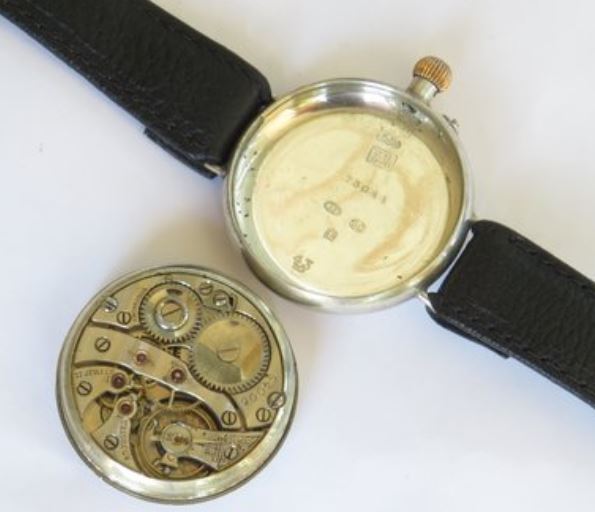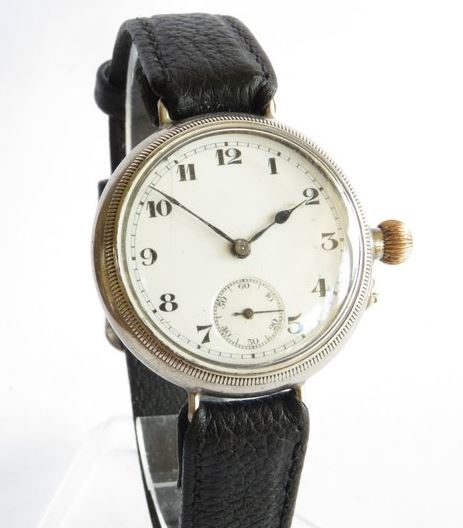The Borgel officer’s watch or Borgel trench watch, so-called because they came into popular use during the First World War when many Borgel cased wristwatches were bought by officers and used in the trenches at the front. They were expensive compared to other wristwatches at the time, but no expense would be spared by the men in the trenches for this potentially life-saving device. A mistimed advance could be fatal for an officer and his men. As a result, a reliable timepiece was critical. Dust, dirt and water were prevalent in the trenches and watches needed protection. This is where Borgel watch cases came into their own.
Francois Borgel
Francois Borgel was born in Geneva in 1856. In 1880, at the age of 24, he started business as a watch case fitter. Borgel was a talented inventor and successful businessman. The Borgel mark, officially recorded in 1887, is formed by the initials of the founder (FB) above the Geneva key. This mark is visible in all Borgel cases. One other important note is that Borgel only made watch cases. Despite reports suggesting otherwise, Borgel did not make jewellery or watch movements. I have noted that there has been a recent attempt to resurrect the ‘brand’ as a watchmaker. This is a little misleading as the heritage is all in the cases, not in the actual watch movement.
Borgel lodged his first Swiss patent in 1888. This was for a process to apply a layer of gold onto a steel plate. Some of the gold was then removed with an engraving tool to expose the steel below. Depending on the amount of gold removed, this could give the appearance of a gold-plated item with the base metal showing through or a steel item with pieces of gold attached.
Patent 4001
Borgel’s most famous patent was for the one-piece screw-in watch case design that now bears his name. The case was designed to be dustproof and more importantly, waterproof. Borgel designed these cases and patented them in October 1891 in Geneva. The Swiss Brevet or patent number was 4001. Additionally, they were patented in London in November 1891 with the patent number 20422. The Borgel case was an early design to try to make pocket watches resistant to dust and moisture. It is a one-piece case, where the movement and bezel are mounted on a threaded ring, which screws into the case from the front. Early adopters of the Borgel screw case included Longines and the International Watch Co. (IWC). Borgel cases continued to be manufactured after his death in 1912, by his daughter Louisa.
The only type of case produced by Borgel in the decade after the patent was registered was for pocket watches. The first Borgel cases for wristwatches appeared sometime before 1910. This was a sign of the times as wristwatches, or wristlets as they were known, were considered effeminate and were not popular for men. The First World War changed all of that as the traditional pocket watch was found unsuitable for trench warfare.
Timing, during warfare, became important, particularly when trying to coordinate attacks against well-organised troops. Soldiers began to wear modified pocket watches on their wrists, with lugs soldered on that allowed wrist straps. A soldier could aim their rifle, and turn their wrist to tell the time, rather than dig through their tunic pockets for their pocket watch. The pocket watch was replaced by the more practical trench watch. Pocket watches continued to be used by the pilots in the Royal Flying Corps.
Components
The components of the Borgel case can be split into the following pieces:
- The bezel and crystal.
- The movement, complete with dial and hands.
- The threaded carrier ring.
- The case screws.
- The Borgel one-piece screw case itself, complete with crown, case stem, and push pin for setting the time.
The carrier ring contains two small holes where the winding stem and the push pin for hand setting, which are mounted on the case, engage with the movement. Another feature of the case is the tube projecting from the side, which contains the winding stem and crown. Typically, most wristwatches do not have a pendant, the winding stem simply projecting straight through the wall of the case, with the crown mounted directly on the end of it. However, in a Borgel watch, the pendant tube is required to enable part of the stem to be withdrawn so that the movement can be screwed in and out of the case.
Assembly
To assemble the watch, the movement is dropped into the threaded carrier ring. The movement is secured to the carrier ring by two case screws. The bezel is then pressed into place on top of the carrier ring and held in place by friction. There is usually a small key on the carrier ring that engages in a slot in the bezel to prevent it from rotating.
The assembled carrier ring with movement and bezel is then screwed into the case. To do this, the spring-loaded crown is pulled away from the case. Once the threads are engaged, the movement assembly can be screwed fully into the case. The crown can then be released to fit in with the winding mechanism. Turning the crown winds the watch. The time is set using a pin-set mechanism.
Impermeable
Borgel advertised his patented screw-watch case as “imperméable”, meaning that he considered his screw case to be waterproof. The Borgel case was certainly innovative for the time and a genuine attempt at making a waterproof watch case. Although, I don’t imagine it would ever be useable as a dive watch. However, I have read numerous anecdotes attesting to the ruggedness and water resistance of the cases. Stories include watches being submerged in rivers for days and going through washing machines without any water penetration. As with any antique or vintage timepiece, they certainly should not be willingly exposed to water. A watch that may have been ‘waterproof’ a century ago, is unlikely to be so now.
In 1924 Louisa sold the Borgel company to Taubert & Fils. The reason for the sale is unknown, but is assumed to be due to economic reasons. Taubert & Fils adopted the Borgel technology and became renowned Geneva-based case makers, specialising in water-resistant cases. They continued producing high-quality watch cases into the 1970s for watchmakers such as Patek Philippe, Vacheron Constantin and Ulysse Nardin.

